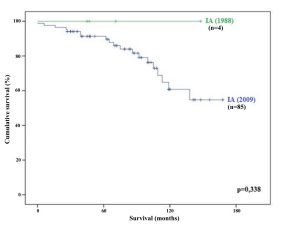Objective: The objective of our study was to compare survival rates using the International Federation of Gynecology and Obstetrics (FIGO) staging system from 1988 versus the one from 2009 in patients with endometrial cancer who underwent surgery and received postoperative radiotherapy.
Methods: A total of 297 patients with endometrial cancer admitted to our department between 1988 and 2008 were enrolled into our study. All 297 patients were staged according to both the 1988 and 2009 FIGO staging systems. We compared survival curves using the Kaplan–Meier method.
Results: The median age was 58 years. Histopathologically, all patients had endometrioid carcinoma. The median follow-up time was 69 months. The proportion of Stage I disease increased from 55.9% to 66.7%. There was no remarkable difference between the survival curves of the old Stage IA and the new one (p=0.338). However, the difference between the old and new Stages IB was significant (p=0.025). There was no remarkable survival difference between the old Stages IA and IB. In addition, Stage IIA and IIB patients had similar survival rates. When the patients with the old FIGO Stage I disease were reclassified, the 5-year overall survival rates for Stages IA and IB were 89.9% and 74.3%, respectively. Stage II disease decreased because 40.5% of Stage II patients migrated to new Stage I. Stage IIIC of the FIGO 1988 was recategorized as IIIC1 (n=25) or IIIC2 (n=12). The 5-year overall survival rate was 61.8% for Stage IIIC1, and 33.3% for Stage IIIC2, with a significant difference (p=0.025).
Conclusion: We found that the new FIGO 2009 staging system was highly prognostic compared with the FIGO 1988 system.
Cite this article as: Yentek Balkanay A, Ergen ŞA, Şahinler İ. Retrospective Evaluation of the Effects of the Old and New FIGO Staging System on Outcomes of the Endometrium Cancer Treatment. Cerrahpasa Med J 2019; 43(3): 85-91.




